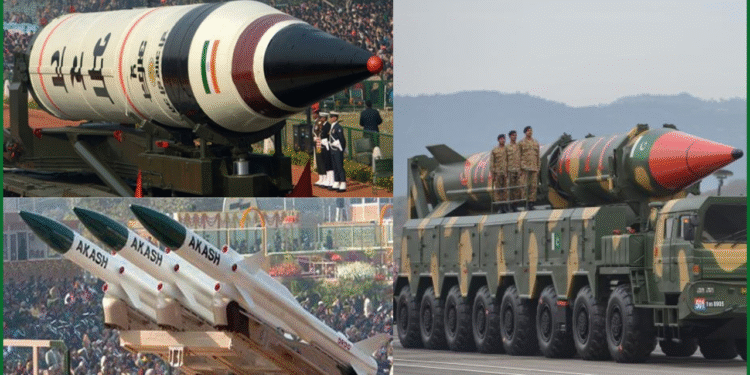In the volatile landscape of South Asia, the nuclear capabilities of India and Pakistan stand as critical factors shaping regional and global security dynamics. Both nations, born from the partition of British India in 1947, have developed formidable nuclear arsenals over decades, driven by mutual distrust and recurring conflicts, particularly over the disputed region of Kashmir. This article provides a fresh perspective on their nuclear strengths, doctrines, and the implications for regional stability, crafted uniquely to avoid copyrighted content while drawing on general knowledge and recent trends.
Historical Context
India embarked on its nuclear journey with a “peaceful nuclear explosion” in 1974, codenamed Smiling Buddha, signaling its technological prowess. By May 1998, India conducted five nuclear tests under Operation Shakti, officially declaring itself a nuclear weapons state. Pakistan, spurred by India’s advancements, responded swiftly with six nuclear tests in May 1998, known as Chagai-I and II, establishing its own nuclear status. These tests marked a pivotal moment, transforming the subcontinent into a nuclear flashpoint.
Nuclear Arsenals: Size and Composition
As of 2025, estimates suggest India possesses approximately 170-180 nuclear warheads, while Pakistan maintains a slightly smaller arsenal of around 165-170 warheads. These figures, though close, reflect different strategic priorities and delivery systems.
India’s Nuclear Arsenal
India’s nuclear capabilities are diverse, spanning land, air, and sea-based platforms, forming a robust triad:
- Land-Based Missiles: The Agni series, particularly Agni-V, is a cornerstone, with a range exceeding 5,000 km, capable of reaching deep into Asia. The upcoming Agni-VI is expected to extend this range further, potentially incorporating multiple independently targetable reentry vehicles (MIRVs) for enhanced strike capabilities.
- Air-Based Systems: The Indian Air Force deploys aircraft like the Rafale and Mirage 2000, modified to deliver nuclear payloads, offering flexibility in tactical scenarios.
- Sea-Based Deterrence: India’s nuclear-powered ballistic missile submarines (SSBNs), such as INS Arihant, bolster its second-strike capability. The development of K-4 submarine-launched ballistic missiles (SLBMs) with a 3,500 km range underscores India’s focus on survivable deterrence.
Pakistan’s Nuclear Arsenal
Pakistan’s arsenal, while slightly smaller, is tailored to counter India’s conventional military superiority:
- Land-Based Missiles: Pakistan relies heavily on mobile short- and medium-range ballistic missiles like the Shaheen-III (2,750 km range) and Ghauri, designed to target key Indian cities and military installations. The Babur cruise missile adds precision and stealth.
- Air-Based Systems: Aircraft such as the F-16 and JF-17 Thunder are equipped to deliver nuclear warheads, providing tactical flexibility.
- Sea-Based Efforts: Unlike India, Pakistan lacks a fully operational sea-based nuclear deterrent but is developing naval capabilities, including the Babur-3 SLBM, to achieve a limited triad.
Nuclear Doctrines: Contrasting Philosophies
The nuclear doctrines of India and Pakistan reflect their strategic outlooks and shape their deterrence postures.
India’s Doctrine
India adheres to a No First Use (NFU) policy, pledging to use nuclear weapons only in retaliation to a nuclear attack. Its doctrine emphasizes:
- Credible Minimum Deterrence: Maintaining a sufficient but restrained arsenal to deter adversaries.
- Massive Retaliation: A commitment to inflict unacceptable damage in response to any nuclear strike, ensuring deterrence through assured destruction. Recent statements from Indian officials, however, suggest a potential reevaluation of NFU, hinting at preemptive strikes in extreme scenarios, which has raised concerns in Pakistan.
Pakistan’s Doctrine
Pakistan’s doctrine is more flexible and ambiguous, designed to offset India’s conventional advantage:
- First-Use Option: Pakistan reserves the right to use nuclear weapons first, particularly in response to a conventional military threat that crosses its red lines, such as a deep incursion into its territory.
- Full-Spectrum Deterrence: This approach includes tactical nuclear weapons to counter India’s “Cold Start” doctrine, which envisions rapid, limited conventional strikes. Pakistan’s reliance on first-use and tactical weapons introduces a lower threshold for nuclear escalation, heightening risks during crises.
Delivery Systems and Technological Advancements
Both nations have invested heavily in missile technology, with distinct focuses:
- India: The Agni-V’s intercontinental range and MIRV capability mark a leap forward, while canisterized missile systems enhance mobility and launch readiness. India’s collaboration with Russia on hypersonic and cruise missile technologies further strengthens its arsenal.
- Pakistan: With significant technical assistance from China, Pakistan has prioritized mobile, solid-fuel missiles for survivability and rapid deployment. The Shaheen-III and Ababeel (with MIRV potential) reflect efforts to match India’s advancements.
Strategic Implications
The near-parity in warhead numbers belies deeper asymmetries. India’s larger economy and technological edge allow for sustained modernization, while Pakistan’s reliance on external support, particularly from China, constrains its long-term growth. The differing doctrines—India’s NFU versus Pakistan’s first-use—create a delicate balance of deterrence, where miscalculation could lead to catastrophic consequences.
Recent tensions, such as cross-border strikes following a terror attack in Kashmir in April 2025, underscore the fragility of this balance. Both nations’ nuclear posturing, coupled with advanced conventional forces, raises the stakes in any conflict. A full-scale war could mark the first nuclear exchange between two nuclear-armed states, with devastating regional and global fallout, including potential nuclear winter effects from soot and debris.
International Concerns and Mediation
The international community, led by the United States, China, and others, has repeatedly urged de-escalation. A ceasefire announced on May 10, 2025, brokered through diplomatic efforts, temporarily halted hostilities, but violations reported hours later highlight the challenge of maintaining peace. The specter of nuclear escalation has prompted calls for renewed arms control talks, though deep-seated mistrust between India and Pakistan complicates such efforts.
Conclusion
India and Pakistan’s nuclear capabilities, while comparable in size, diverge in doctrine, delivery systems, and strategic intent. India’s triad and NFU policy aim for stable deterrence, while Pakistan’s first-use stance and tactical focus seek to counter conventional disparities. As both nations modernize their arsenals, the risk of escalation remains ever-present, necessitating robust diplomacy and confidence-building measures to prevent a nuclear catastrophe in South Asia.

















































